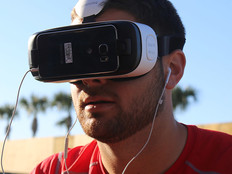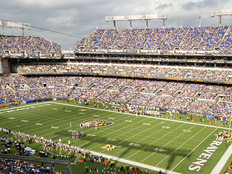What Is the Tech Behind Immersive Sports Experiences?
At this year’s Consumer Electronics Show, Intel CEO Brian Krzanich gave attendees of the company’s press conference the option of watching an NCAA men’s basketball game between Villanova and Butler in virtual reality. The demo was made possible because of Intel’s acquisition in November 2016 of VOKE, a VR startup focused on bringing live, immersive virtual reality experiences to users across multiple platforms.
As The San Diego Union-Tribune recounted:
“With the headsets, their perspective was as if they were sitting in the stands watching the game in person. (A big problem with virtual reality is its tendency to make people nauseated. So Intel provided barf bags in case anyone felt ill.) If they looked up, they saw the scoreboard. Overlaid on the right side of the screen were conference standings. Looking ahead, they saw the court. Unfortunately for Krzanich, the demonstration occurred during halftime, with the players just returning to the floor. But it did offer a snapshot of what virtual reality could eventually bring to sports programming.”
If this is where the future of sports viewing is heading (and it’s still a big if), the companies that design such immersive experiences are going need a great deal of technology to support all the VR pyrotechnics.
While the consumer market is focused on VR headsets and goggles, the computing and networking horsepower needed to deliver such experiences to fans in real time must be just as robust, and maybe more. And that technology will need to get more powerful if more consumers jump on the VR bandwagon and start pushing for teams and leagues to provide such experiences at stadiums or at home.
The Tech Behind Immersive Sports
For James Carwana, general manager of the Intel Sports Group, immersive sports technology is now at the point “where video is no longer just something that sits on a flat surface and that fans are satisfied merely watching at arm’s length or from across the room.” Intel is clearly riding the opportunity and hopes that its technology (and the tech of the companies it has acquired) can help power those experiences.
“The sports industry is at a critical inflection point to bring fans, athletes and coaches the most dynamic, compelling and engaging immersive experiences across every sport,” Carwana says.
In the past year, Intel has integrated its technology at the 2016 MLB and NBA All-Star games, the 2016 NBA Finals, the U.S. Open golf tournament and Super Bowl 51. La Liga, the top Spanish soccer league, also became the first European league to install Intel’s 360-degree replay technology during the El Clasico encounter between FC Barcelona and Real Madrid in December 2016.
“We’re continuing to explore new partnerships with teams and leagues, while expanding the scope of our technology, including 360-degree replay technology and our investment in VOKE,” Carwana says.
VR and high-definition replays can generate a lot of data for teams, leagues and the networks they use to transmit the data, not to mention the servers or cloud services they use to store the information.
As the use of VR content and immersive video expands, the data generated from them is increasing. According to Carwana, the Intel 360 replay technology uses 38 HD 5K cameras to capture the action on a basketball court or playing field, which produces “a massive amount of data" — each 15- to 30-second clip generates over a terabyte of data.
Intel is relying on its chipsets, networking and server technology to help process, send and store all of that data. Teams and leagues that want to enable these kinds of experiences — and deliver them to fans in real time — will need to lean on partners that can take advantage of high-performance computing power and networks that can provide significant amounts of bandwidth for sustained periods of time (as all that data gets transmitted).
Carwana notes that at Super Bowl 51, Intel installed the 38 HD 5K cameras, all of which were synchronized to exactly the same frame to create the full 360-degree view for each replay. Then, the cameras sent the 5K signals over fiber-optic cables to the server room where Intel created a dynamic, three-dimensional and 360-degree reconstruction of the play. At the recent MIT Sloan Sports Analytics Conference in Boston, Carwana noted that after New England Patriots quarterback Tom Brady threw an interception that was returned for a touchdown, Intel was able to give fans a VR view of the play from Brady’s perspective.
Where Is Immersive Sports Going?
It’s definitely an open debate about whether VR and immersive sports will gain a mass following anytime soon. The market is still in a bit of a chicken-or-egg dynamic. Miheer Walavalkar, co-founder and chief business officer of VR firm LiveLike, noted at the Sloan conference that fans are generally unwilling to invest in VR hardware unless they have a lot of content to experience. Content producers, however, have been waiting for a stable and sizable market to emerge to target with content.
What seems more certain is that technology will continue to advance. Carwana notes that the turnaround time for a replay is likely to drop. Currently, it takes 90 seconds to generate a replay from Intel’s 360-degree technology.
“As the technology improves and speeds up, we’ll be able to offer instant replay,” he says. “5G [network technology] is another example. With 5G speeds, there will be a much better VR experience with little latency.”









